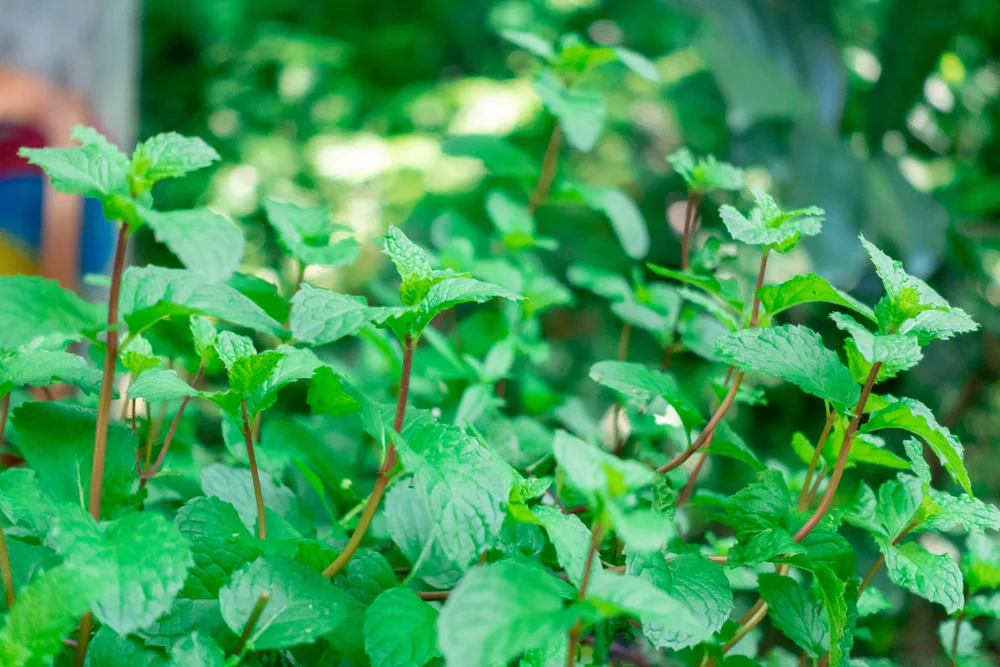
Mint is aromatic and pleasantly intoxicating, with cooling/soothing menthol flavors which have both culinary and medicinal properties.
Plus, it is a perennial herb that is easy to grow. Yet, it is notorious for escaping garden boundaries in search of more space to expand its horizons.
In fact, it can spread 4″ per month, or more! This may not seem like much, but the more it gets rooted in a particular area, the faster it will grow and sprawl as new plants are created in the process – leaving you wondering if growing mint is worth the little effort involved.
It is.
For there is little to fear about a fragrant patch of mint, in the garden or potted in containers, as there are ways to limit their unlimited growth.
In its abundance you are sure to find your own reasons for letting mint thrive in your garden – whether you keep it for fresh mint ice cream, refreshing mint lemonade, or to attract more pollinating insects to your garden.
A short history of mint
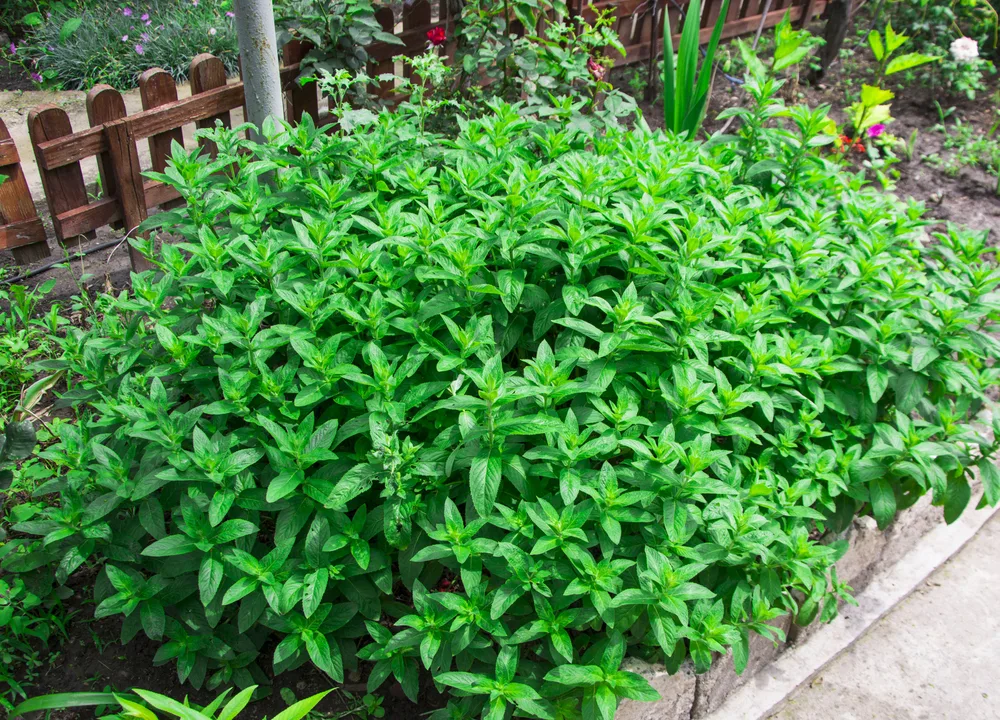
Mints (Mentha spp.) are wonderful herbs that have been used since ancient times for both culinary and medicinal purposes.
Its use as a medicinal oil has been documented as early as 410 AD. Romans used it for perfumes, as well as flavoring drinks and wine.
Along with lavender and sage, peppermint was considered a digestive aid in medieval times, such as it remains today.
It has also been said that the leaves of peppermint were dried and powdered, not only for herbal teas (only drink one or two mugs at a time, lest you feel nauseous), but for keeping teeth healthy and white.
Mint is also good for treating and soothing symptoms of the common cold. Being an aromatic decongestant that helps to clear the lungs.
Go easy on the amount of mint you use at once, though. You don’t want to overdo it!
Varieties of mint
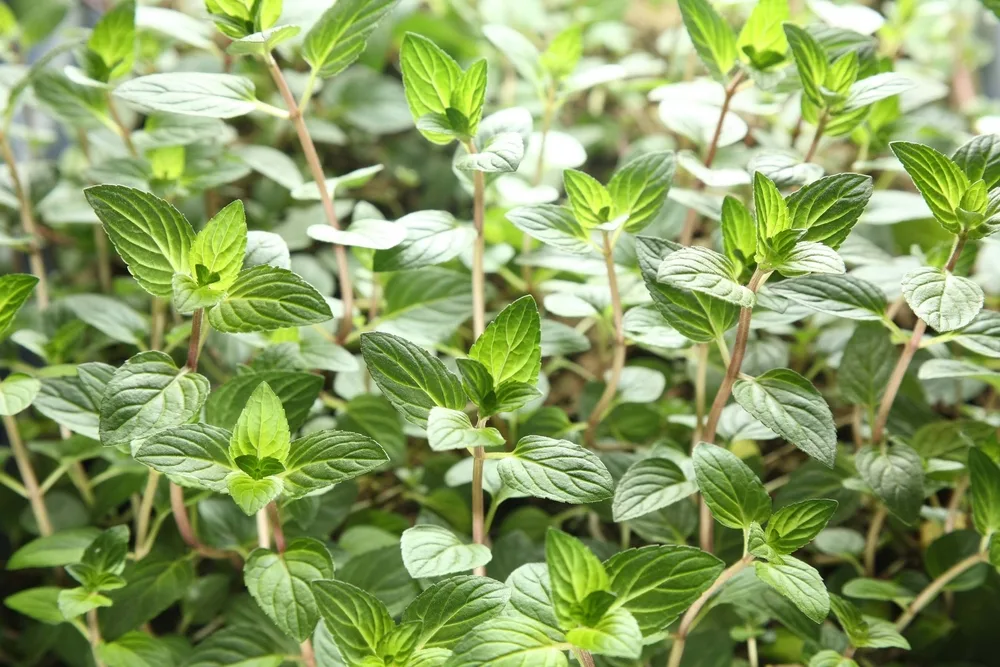
With over 600 varieties of garden mint to choose from, it is hard to stick to growing just one.
While some of them can be used interchangeably, many are noted for their specific flavors. You will need to explore them on your own to discover which ones you like the best.
The most common garden mints are:
- peppermint
- spearmint
- chocolate mint
- apple mint (woolly mint)
- pineapple mint
- lavender mint
- ginger mint
- strawberry mint
- catmint
- horsemint
- Corsican mint
- Egyptian mint
- pennyroyal
- watermint
This list is just the beginning, to help you get a taste for the diverse mintiness that is out there. I encourage you to explore what grows wild in your area as well, provided you know how to identify mint. The flavors of wild foraged mints may be more mild (or more intense, it depends on the growing conditions) and suitable for adding to your plantain and nettle herbal tea.
You will be pleased to know that mint is a wonderful perennial to have in your garden. You can harvest it year after year, with reliable results.
Never fear: it will not take over your garden, so long as you maintain your mint patch by harvesting regularly and containing the sprawling roots.
Mint for eating
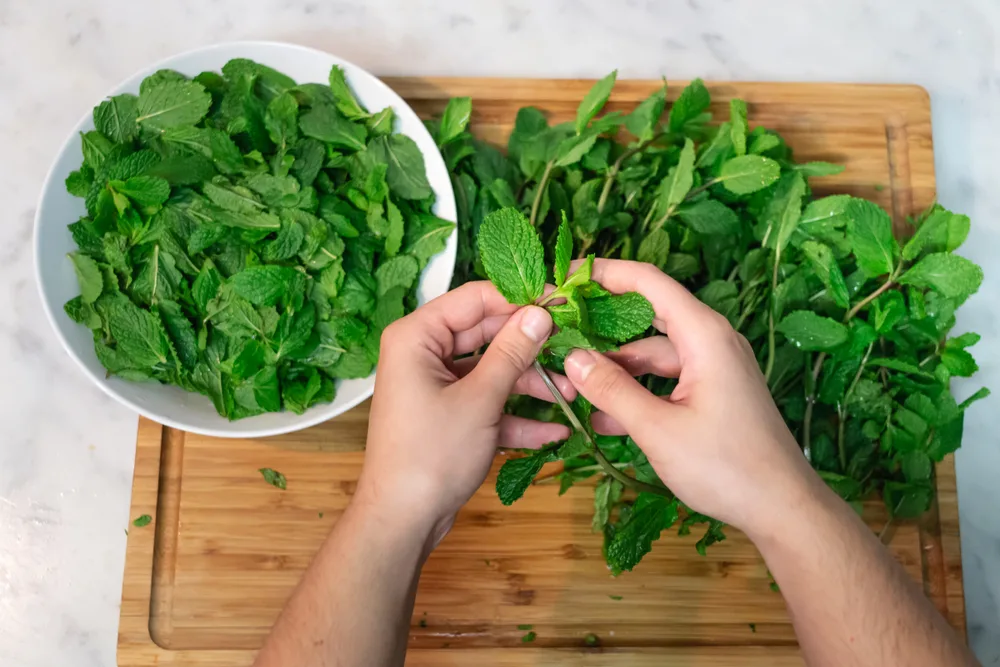
There are three main reasons to grow mint in your garden, or alongside your house. For eating, for drinking and for promoting diversity in the garden.
Within these reasons, and given that you have sought out a variety (or several varieties) of mint that you love, here are 16 more reasons to keep eating, drinking and using mint in ways that are all new to you.
Please, feel free to pass along your favorites!
In the meantime, imagine rolling up a mint leaf, popping it in your mouth and gently massaging it between your teeth.
What do you feel? How does it taste? Would your ideal mint be better suited to pesto or mint sauce, or something entirely different?
1. Basil mint pesto
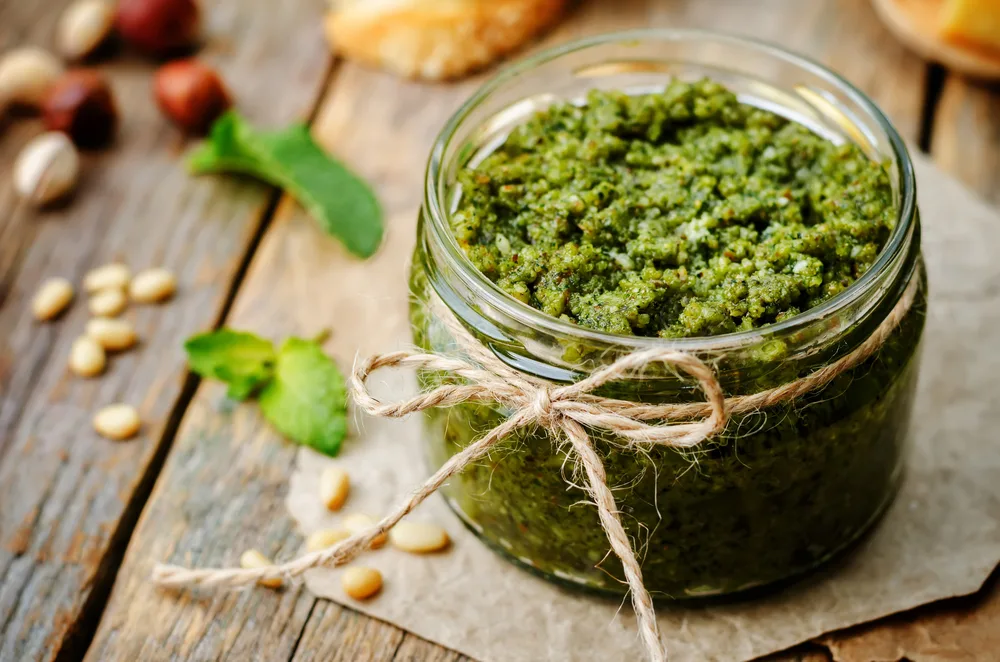
If you happen to grow a ton of basil, chances are good that you are already a fan of pesto. Who isn’t?
Have you ever stopped to consider what that might taste like if you added half a cup of mint leaves and chopped walnuts to the mix?
Superb. That is the correct answer.
You can find the best mint pesto recipe here:
Basil Mint Pesto @ Fork in the Kitchen
2. Coriander-mint chutney
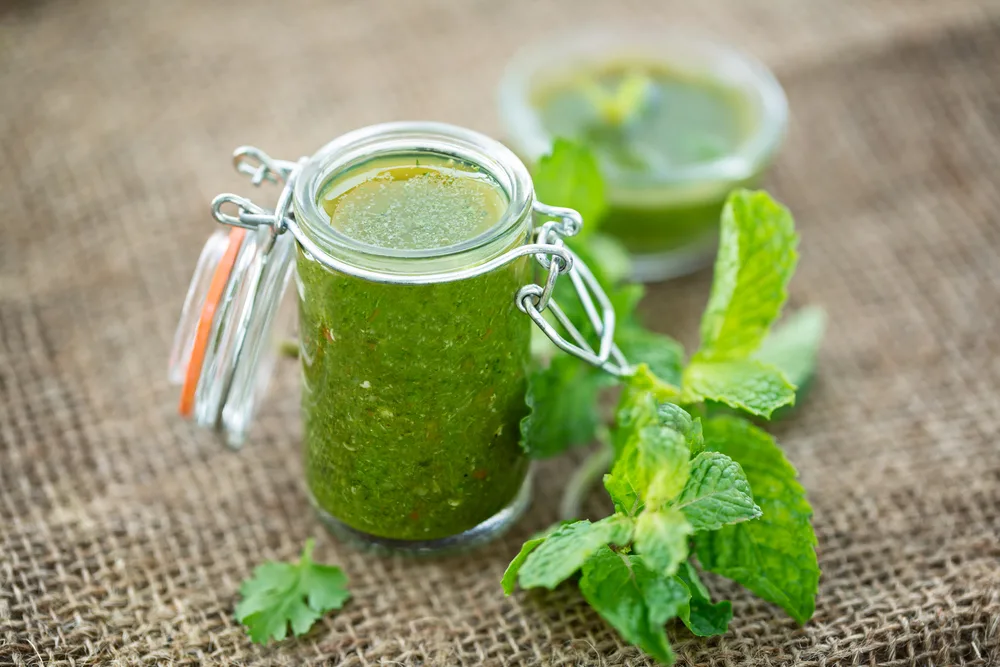
If you have been searching for a completely different way to sample the massive amount of mint from your garden, this reason is for you.
It takes fresh mint leaves, fresh coriander leaves (cilantro), green chilies, ginger, cumin powder and black salt. Fresh lemon juice is optional, and if you happen not to have black salt, any salt will do.
Blend all ingredients to a smooth paste, then serve with your favorite Indian foods.
It is lean, green and powerfully flavorful. You simply must try it this season.
Mint Coriander Chutney @ Veg Recipes of India
3. Mint sauce
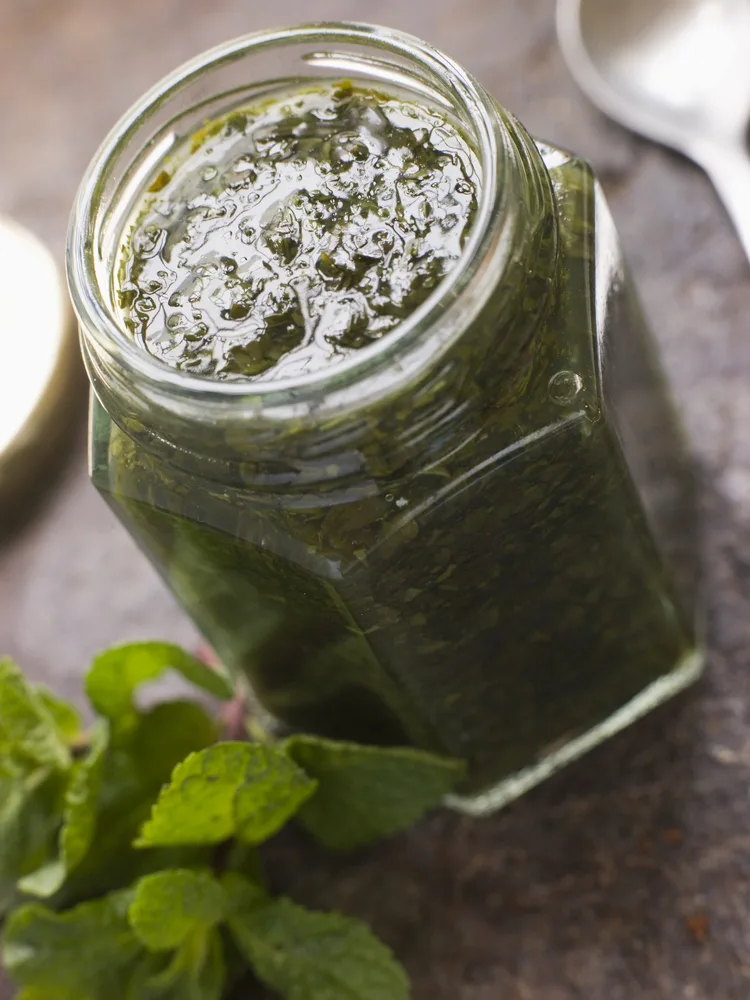
The first time I ever tried mint sauce was in England, where it remains part of a traditional Sunday roast to this day.
It is extremely easy to make, contains few ingredients (fresh mint leaves, white wine vinegar and sugar) and perfectly complements roast lamb.
If you are wanting to try a classic British/Irish condiment, mint sauce is your go-to recipe.
Easy Real British Mint Sauce @ the Spruce Eats
4. Fresh mint ice cream
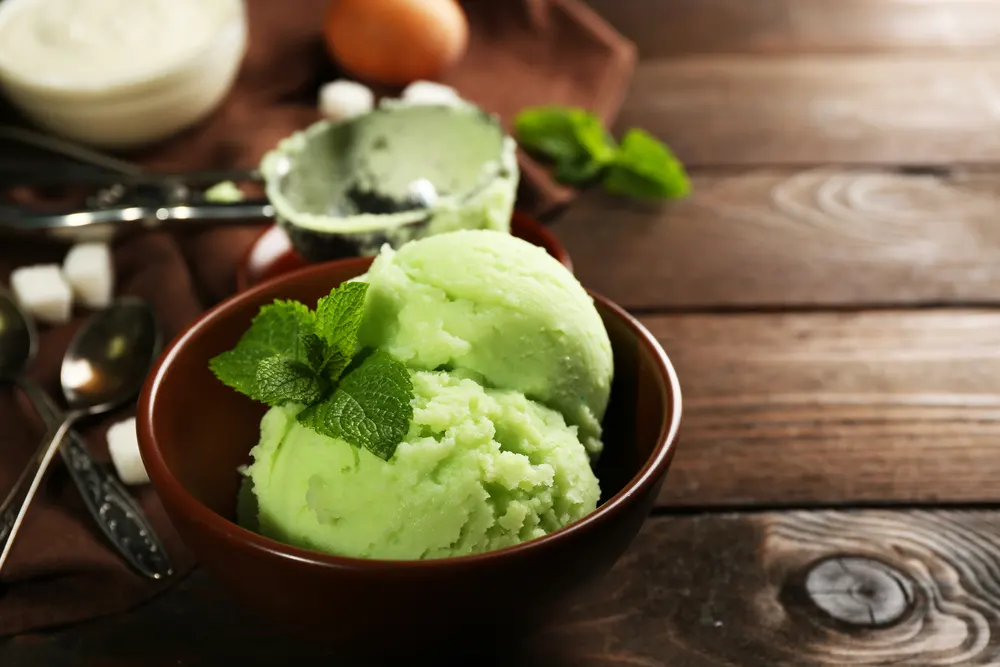
If you aren’t one for mint sauce, here is another, sweeter suggestion for using up some garden mint – mint ice cream.
With an ice cream maker and all the ingredients to make it happen, you can sit in your own little minty world as you eat spoonful after delicious spoonful of creamy goodness.
Why buy store-bought, when it can be made so much healthier, fresh and flavorful mint ice cream at home?
Fresh Mint Ice Cream @ Cookie and Kate is the recipe you need.
5. Chocolate-dipped mint leaves
One really special way to indulge in fresh mint leaves is when they are dipped in chocolate – the darker, the better.
Eat them straight up, as is, or serve them as a garnish with fruit salads or vanilla ice cream.
Mint leaves dipped in chocolate is typically an adults-only treat, as younger children may find the mint intensity too outlandish. Give them a scoop of mint ice cream instead.
Chocolate Mint Leaves @ Healthy Recipes
6. Mint added to salads
You might be surprised with what mint pairs well with.
Add it to a spring salad with walnuts and Parmesan, or toss some mint leaves in a cucumber salad with onions and white wine vinegar.
It also goes down well in a watermelon feta salad. Don’t you love it when summertime flavors meld so fabulously together?
7. Mint in yogurts
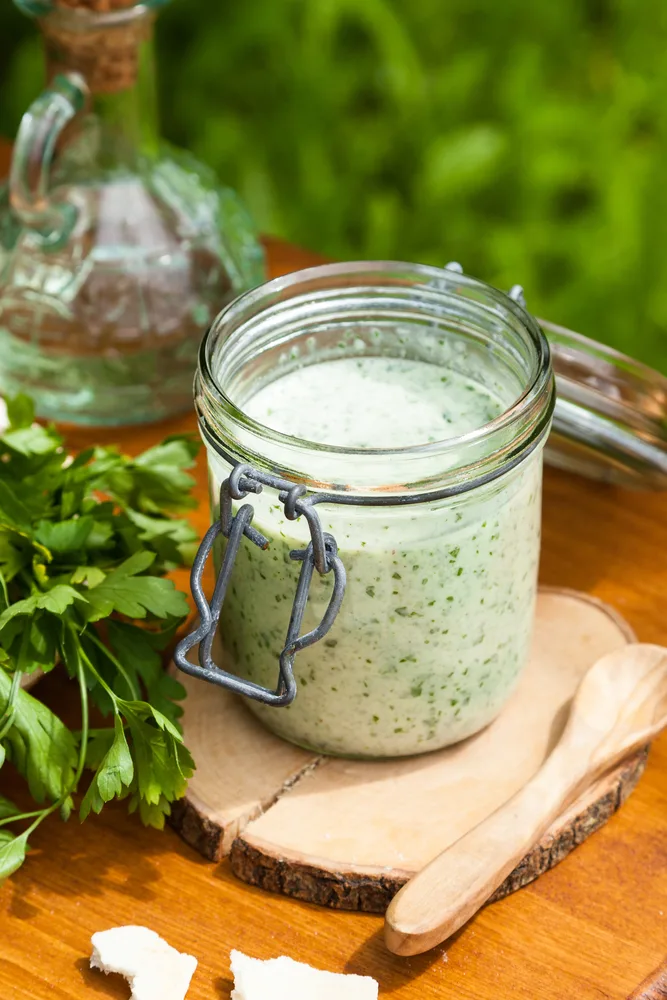
Whether you are adding a few fresh leaves of mint to your morning yogurt, or to a cooling yogurt mint sauce, there is no way you can go wrong.
To make a yogurt mint sauce to serve alongside fresh garden veggies or grilled meats, here is all you need:
- 1 cup yogurt (water buffalo or goat yogurt are both amazing, be adventurous!)
- 1/2 cup fresh mint leaves, finely chopped
- 1 garlic clove, minced
- 1 tablespoon lemon juice
- salt and pepper, to taste
- cayenne pepper, just a dash – optional
Instructions for mint yogurt sauce:
It cannot be easier than preparing all ingredients and whisking them altogether. Cover and refrigerate one hour until the flavors infuse with each other.
Store for up to one week in the fridge.
This is one of the best ways to use up a bunch of mint really fast. Use it as dressing for salads, dip your baked chicken in it, smother your burger, you get the point. It is tasty and sometimes that is all one really needs to know.
You can easily make it dairy-free by adding your favorite coconut-almond-soy or homemade cashew yogurt.
Mint for drinking
If you wish to preserve your mint for winter, for warming teas all throughout the colder months, it is a wonderful skill to learn to air-dry your herbs at home.
All it takes is a piece of string and a nail to hang a bunch of mint on, out of direct sunlight. With those three criteria, you can dry just about any edible garden or foraged herbs you come across. It makes wintertime that much more enjoyable when you can savor the fruits of your labor.
Guests will love to stop by and sip a cup of mint tea along with a friendly chat too.
8. Mint tea
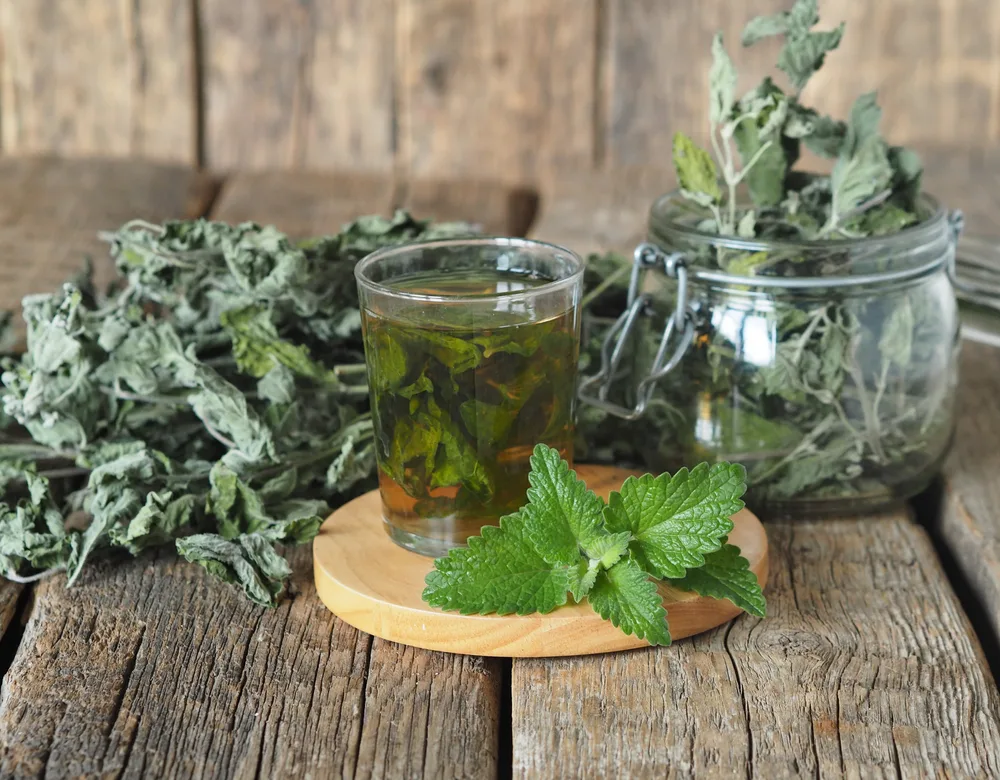
We’ve just mentioned drying your own mint.
Reality is, mint tea can be made with either fresh or dry leaves. So, it really is always in season.
You will want to play around with amounts though. Too much mint can make you nauseous. Just the right amount will settle your stomach and put you at ease. Plus, it is caffeine-free, so feel free to consume it even before bedtime.
In summer months, when mint is reaching over the garden path and out through the garden gate, we always harvest a sprig or two fresh, as we leave the garden. The mint always has a way of reminding us: it is time to pluck and prune it back.
Once inside, straight into a pot of boiled water it goes. Then it is instantly removed from the stove. Let it steep no longer than 5 minutes, strain and serve hot. Or let it come to room temperature before refrigerating it to serve cold the following day.
For 4 cups of fresh mint tea, two sprigs are usually enough to really feel the minty flavor. For those of you who love to count, that is about 22-34 leaves.
Honey is optional, as many times we find the mint sweet on its own. Although a slice of organic lemon always feels nice alongside.
If you are using dried mint to make tea, use much less. The flavors will become concentrated over time.
In the case of using dried mint, we find it beneficial and tasteful to add it to other herbs such as red clover, plantain, raspberry stem, or even nettle.
9. Mint lemonade

Just as in tea, mint pairs beautifully with lemon.
You get to choose, the classic way (plain version) or the frothy version. Both are perfect for summer when mint is in utter abundance.
You’ll want to be aware that when searching for a mouthwatering lemonade recipe, that sugar is often a big part of it. It helps to balance out the acidity of the lemons.
Don’t compromise your health by imbibing on too much sugar under the hot sun. Go for a low-sugar option and quench your thirst with a glass of lemonade that is truly refreshing, not just sweet.
Mint Lemonade Recipe (Low Sugar) @ Pickled Plum
Mediterranean-Style Mint Lemonade (Limonada) – the frothy version @ The Mediterraneadn Dish
10. Mint smoothies
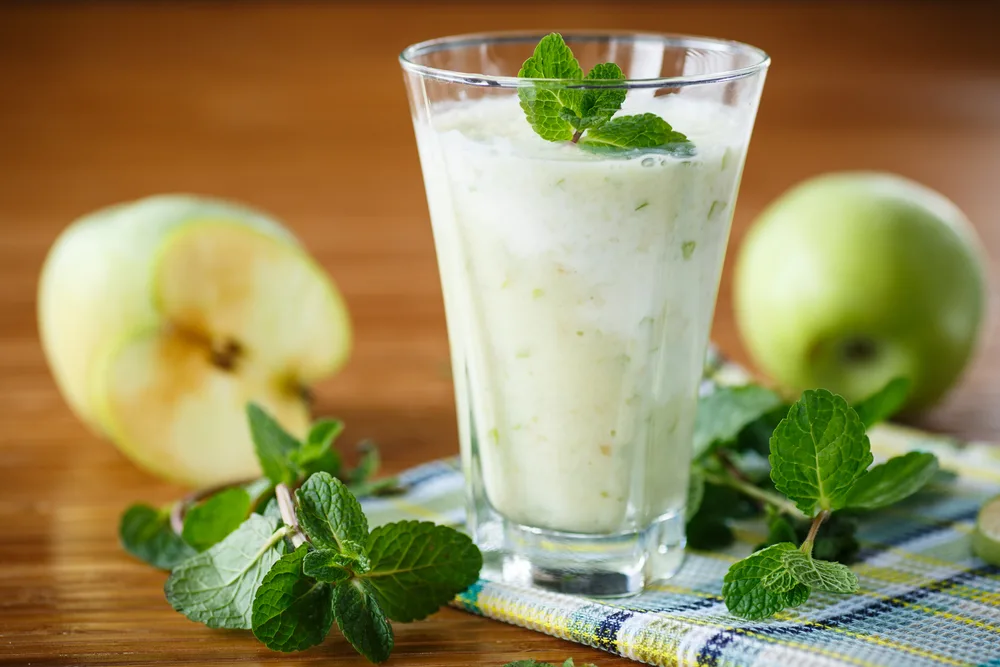
Another way to graciously enjoy your overabundance of mint, is to blend it in a smoothie. For breakfast, after lunch or an afternoon snack.
Here are a few mint smoothie recipes to get your mind started on other ways you can incorporate more mint into your diet:
Strawberry Mint Smoothie Recipe @ Home Cooking Memories
Energizing Cucumber Mint Smoothie @ Happy Healthy Mama
Pineapple Mint Smoothie @ From My Bowl – you can even use frozen zucchini in your mint smoothie!
11. Watermelon-mint cooler

Once you have tried a lemon-mint cooler, a mango-mint cooler, a strawberry-mint cooler and a citrus-mint cooler, then you are definitely ready for a watermelon-mint cooler.
Or perhaps you have been ready for a sip all along.
There is a prerequisite though – you must enjoy watermelon. This option exists for those watermelon enthusiasts who simply cannot pass up on a mint mojito when it comes their way.
It is also useful to know that there is more than one way to make a mint cooler. This recipe uses ginger ale, lime juice and aromatic bitters to spice it up, with an option of adding white rum with the mint before chilling, for an exciting adult version.
This refreshing watermelon-mint cooler has added salt to it, no sugar and no fizz. More on the plain and simple side to be sure, yet, if you’ve been working out in the garden all day, it is a sure-fire way to bring energy back into your aching muscles. It is a tasty way to prevent dehydration on a hot summer day!
12. Mint cocktails

An entire article could be written solely about mint cocktails – and I’m sure it has already been done. For the sake of discovering a few recipes quickly, we’ll share a few below.
There is no need to convince you to try any of these, they are all up to your discretion and alcohol preference. Just don’t sample them all at once!
Cucumber Mint Gimlet (made with gin)
Classic Bourbon Mint Julep (made with bourbon whiskey)
The Real Mojito (made with white rum)
Non-Alcoholic Mojito (made with elderflower cordial and apple juice)
Other uses for mint
Planting mint in your garden is not only a good idea for you. It helps others too, such as the pollinators in your garden.
While there are many flowers that can be grown just for bees, it is good to know that mint acts as a repellent to other unwanted garden visitors at the same time.
It is truly an herb with magical properties. I couldn’t imagine our garden without a calming patch of mint near the entrance.
13. Attract bees and other garden pollinators
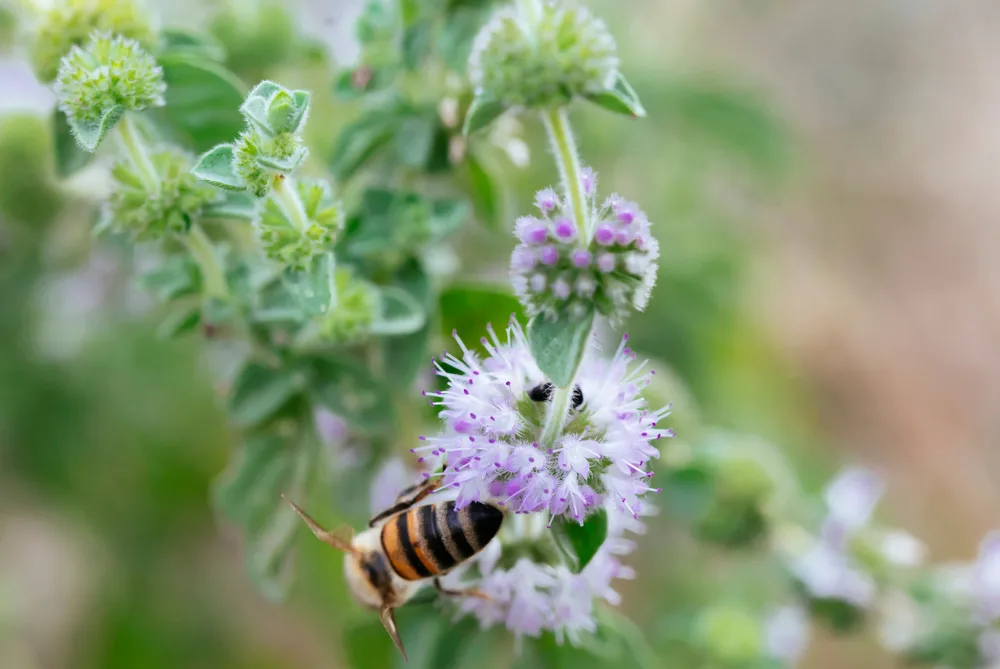
Mint attracts honey bees, native bees, bumble bees and a whole suit of other beautiful winged creatures.
While most true mints have been introduced to North America, for the purposes of commercialization, one native species flourishes in the wild. If you can reintroduce it to your garden, the bees would appreciate it.
It goes by the names of field mint, wild mint or corn mint, it’s Latin name being Mentha arvensis.
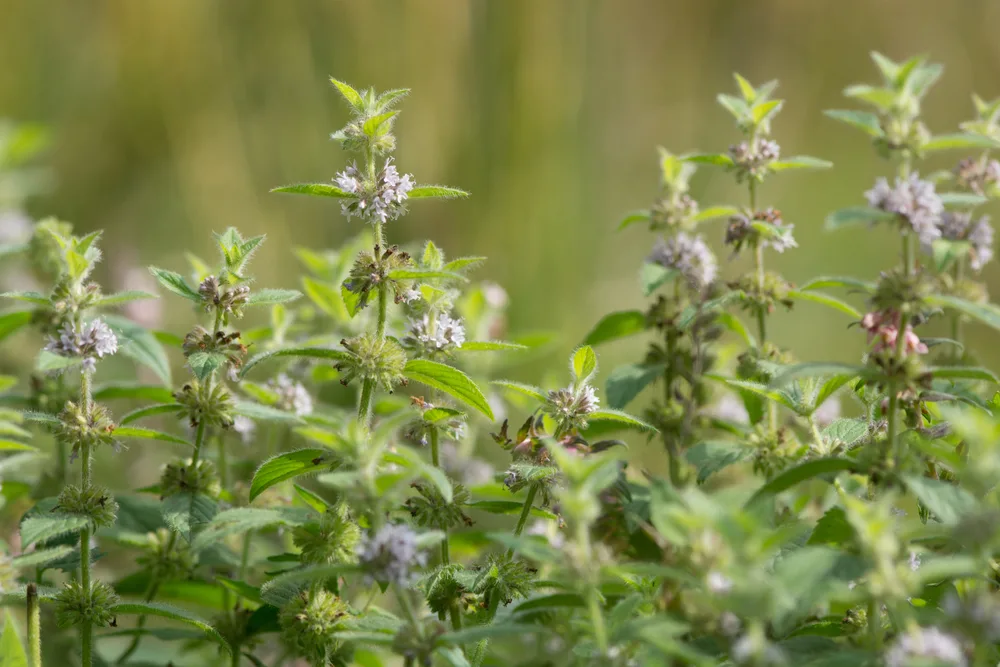
If you have ever tasted the honey produced near mint farms, or valleys covered in mint, you will know of its value.
Here is a little taste of what mint honey looks and tastes like.
14. Mint as mosquito repellent and ant deterrent
If you are thinking holistically and wish to deter mosquitoes without chemical sprays, you may wish to try using mint and see how it works for you.
When working out in the garden, simply pluck a sprig or two and rub it on your exposed skin for quick protection.
You can also make a mint insect repellent spray by crushing a handful of leaves, adding them to a pot of boiling water, then leaving it to sit for 12 hours. Then you can strain the mint infusion and mix it with an equal part of rubbing alcohol. Pour it into a spray bottle and use as needed.
In the home, to prevent ants from invading, place some sprigs of mint where they are trying to enter. Try spraying a mixture of peppermint essential oil mixed with water near windows and baseboards to deter ants.
Mice are not fond of peppermint smell either. While it is a natural remedy of sorts, it isn’t enough to get them to leave your house completely. However, it works great in combination with catching them and/or having a barn cat (or owl) come in to do the job they do best.
15. Mint as a companion plant
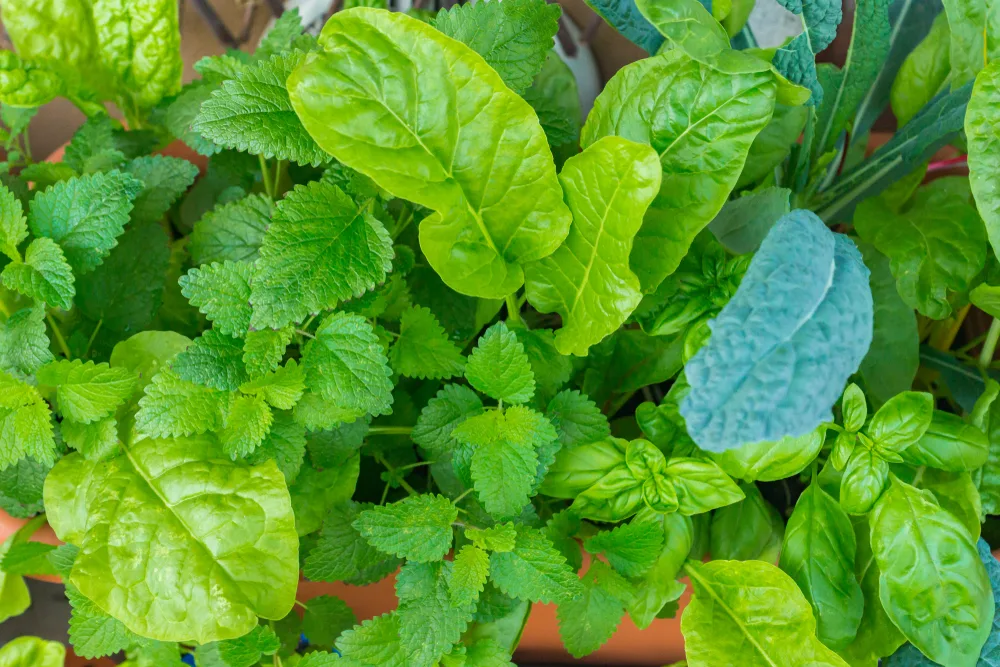
While mint has an aromatic scent that most humans enjoy, it isn’t a smell adored by all.
Several animals and insects dislike the odor of mint, and it is known to repel ants, mice, deer, spiders and cockroaches to name but a few.
It comes in handy to have a thriving mint patch in the garden to deter cabbage moths and other insects that prey on your cabbages and tomatoes.
Mint is also a companion plant for beets, broccoli, Brussels sprouts, cauliflower, eggplant, kale, kohlrabi and lettuce.
Just avoid planting mint near parsley or chamomile.
16. Mint for homemade salves and soaps
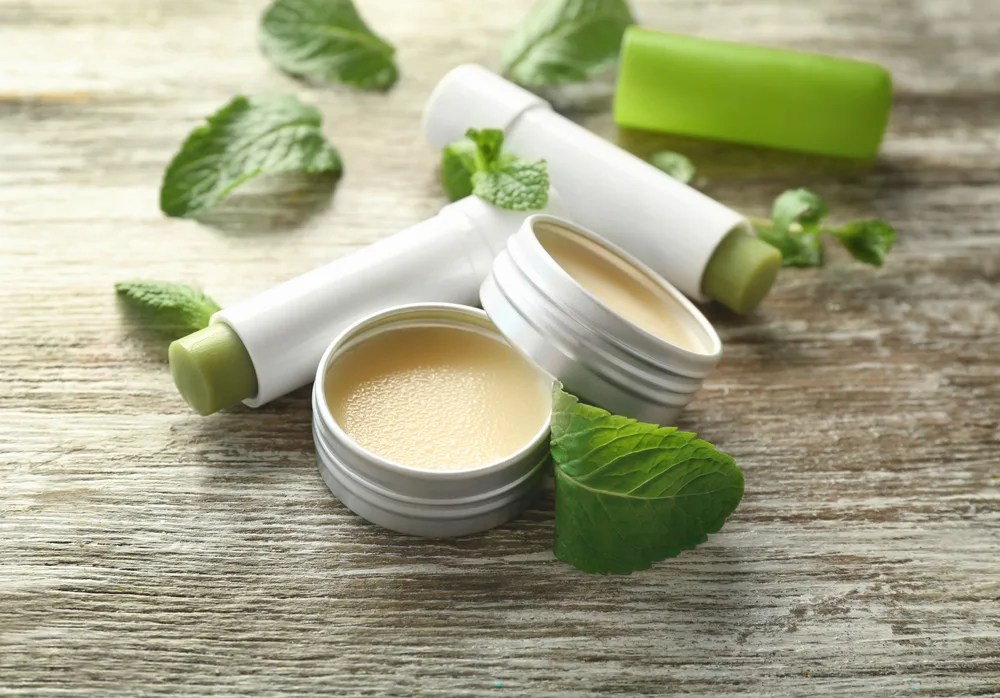
One more reason to grow mint in your garden is for the use in homemade salves and beauty products.
Whether it is to combat dry-cracked skin, to refresh your face and hands or to stop a headache in its tracks, mint is wonderful when used externally.
Here are a few DIY mint recipes to try making this summer, while mint is in season:
Peppermint Pine Headache Salve @ Reformation Acres
Homemade Peppermint Salve (for dry winter skin) @ Melissa K Norris
Garden Mint Soap Recipe @ The Nerdy Farm Wife
Controlling the spread of mint in your garden
Now, that you know mint is a must-have in your garden, how are you going to control it?
The easiest way to control the sprawl of roots, is to keep mint in containers. Some mints are perfect for use in hanging baskets, others look great among a selection of similar herbs.
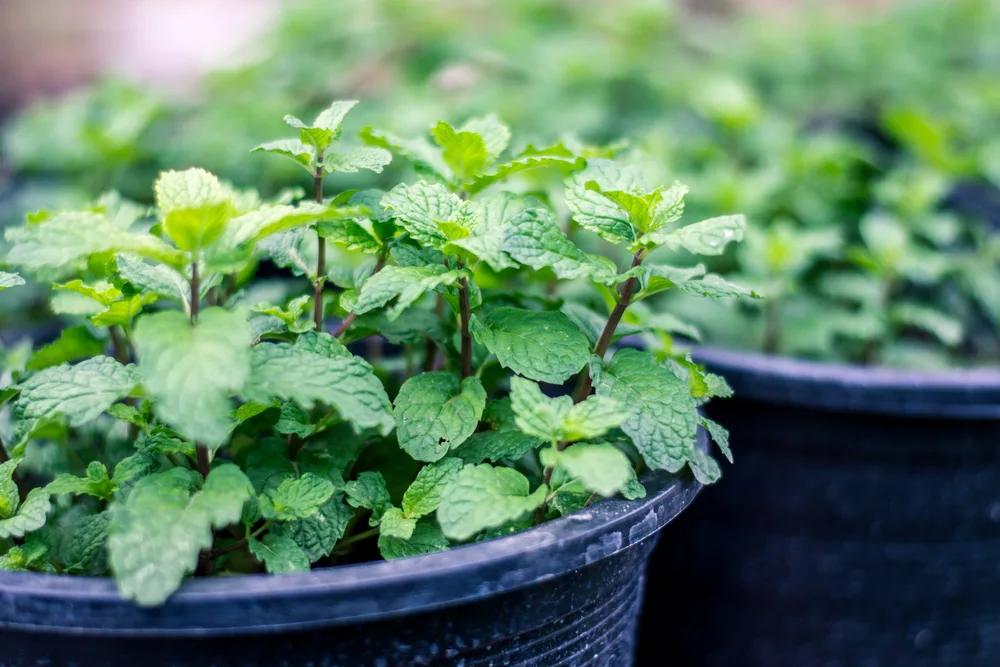
Outside of growing mint in containers, you can also control the spread of mint by sinking boards into the ground (6-10″). Or by planting them next to a wall, mowing or cutting them back when necessary.
If, and when, you want your mint patch to grow even larger, you can just let it be and allow nature take its course, or you can urge it on by learning to propagate mint by using root division and stem cutting techniques.
With an abundance of mint in the garden, you will never run out of exciting drinks and dishes to try, you may just help more insects to thrive too!

Get the famous Rural Sprout newsletter delivered to your inbox.
Including Sunday ramblings from our editor, Tracey, as well as “What’s Up Wednesday” our roundup of what’s in season and new article updates and alerts.


